This pale blue-gray beauty is a total stunner, with a ghostly glimmer that makes it a standout succulent. Also known as the ‘Ghost Echeveria’, this Mexican native earned its spooky street cred thanks to the silvery-white, powdery coating on its leaves. But don’t be frightened off by its otherworldly charm – this member of the Crassulaceae family is actually a low-maintenance charmer that’s perfect for beginners and succulent pros alike.
Dig in!
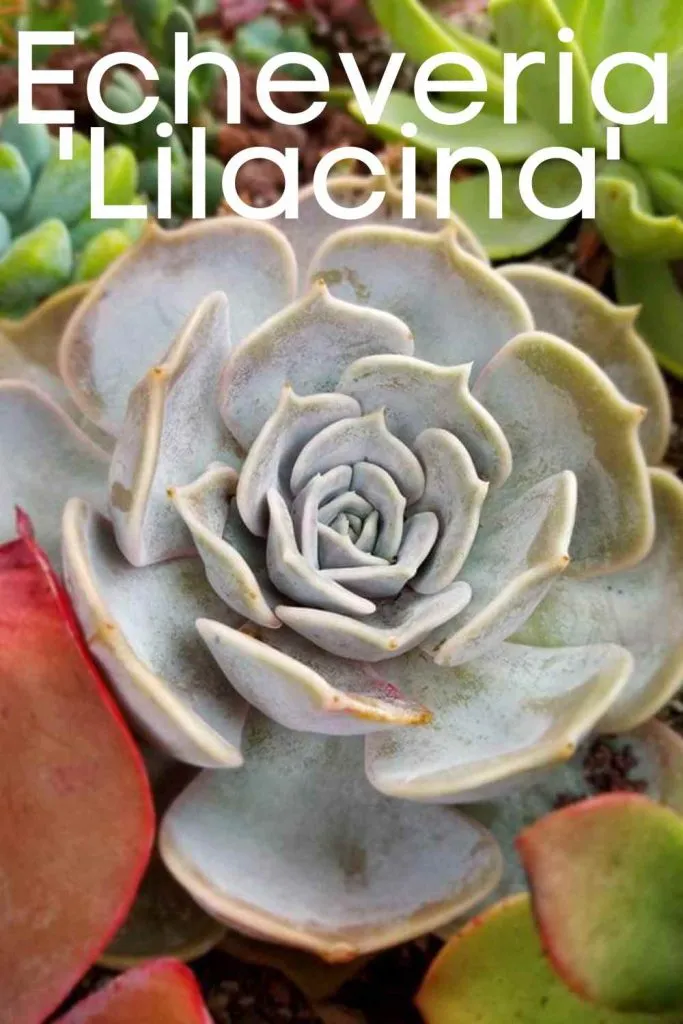
Whether you bring its ethereal elegance indoors or add it to your outdoor succulent garden, the Echeveria lilacina ‘Ghost Echeveria’ has similar needs: lots of bright light, well-draining soil, and not too much fuss. To keep it looking its ghoulish best, place it in a sunny spot and water when the soil is dry, avoiding overwatering at all costs. This succulent holds onto water in its leaves, so drenching it can lead to rot. A mix of potting soil, perlite, and grit or sand provides the quick-draining medium it prefers.
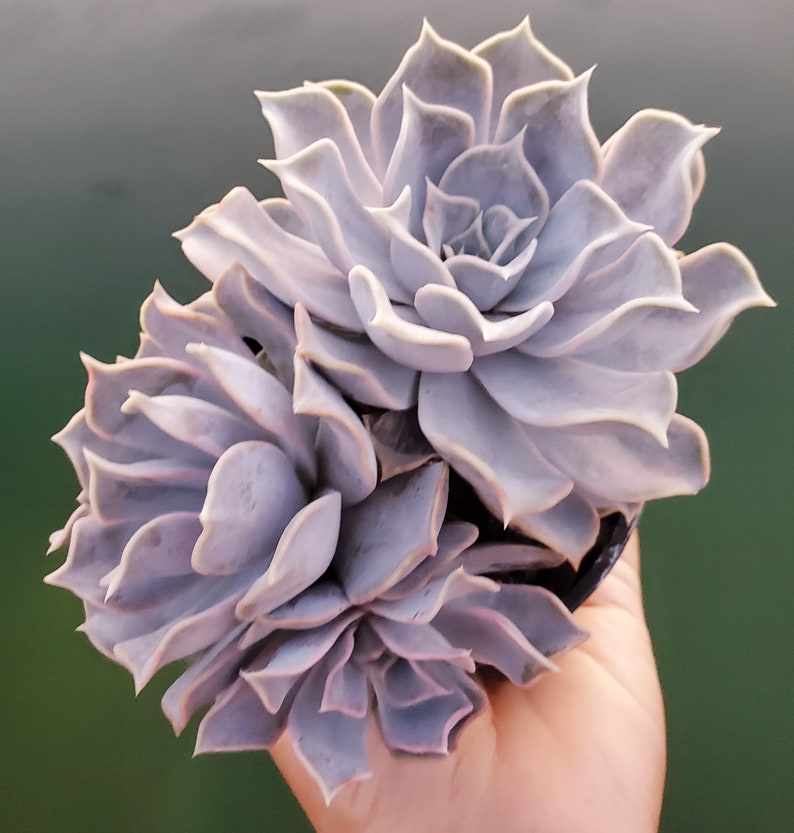
Source: Etsy
Unique Adaptations
Echeveria ‘Lilacina’ exhibits several unique adaptations that set it apart from other succulents. One notable feature is its rosette-shaped leaves, which form a tight arrangement, allowing it to conserve water. The powdery coating on its leaves serves as a protective layer, reducing water loss through transpiration and providing some degree of sun protection.
Appearance and Growth Habits
Echeveria ‘Lilacina’ showcases a mesmerizing display of soft, silvery-blue leaves. The leaves are spoon-shaped and slightly curved, giving them a graceful appearance. The plant forms compact rosettes that can reach a diameter of about 4-6 inches (10-15 cm) when fully mature. Over time, the rosettes can produce offsets or “pups” around the base, allowing for natural propagation.
Flowering and Bloom Triggers
When in bloom, Echeveria ‘Lilacina’ produces slender, arching flower stalks that can reach a height of 12-18 inches (30-45 cm). The flowers themselves are tubular and come in shades of pink, coral, or orange. Typically, Echeveria ‘Lilacina’ blooms in late spring or early summer, and the onset of blooming is often triggered by longer daylight hours and warmer temperatures.
Growth Rate and Seasonality
Echeveria ‘Lilacina’ has a moderate growth rate compared to some other succulent varieties. It tends to grow more actively during the spring and summer months when temperatures are warmer and daylight hours are longer. During the fall and winter, its growth rate may slow down as it enters a semi-dormant state.
Indoor Growing and Toxicity
Echeveria ‘Lilacina’ (Ghost Echeveria) can be grown indoors, as long as it receives adequate sunlight. Place it near a window with bright, indirect light, and ensure good air circulation. Indoor humidity is generally lower, which aligns well with the succulent’s preferences.
It’s important to note that Echeveria ‘Lilacina’ is non-toxic to cats, dogs, and humans. This makes it a safe choice for pet owners and households with small children.
Fertilizing
Fertilize during the growing season, but go easy since too much food can stress the plant. If branches get leggy, try giving it more sun and pruning to shape its form. With the right mix of TLC and neglect, your Echeveria ‘Lilacina’ (Ghost Echeveria) will thrive and delight with its dreamy, otherworldly charm.

Succulent fertilizer available to purchase on Etsy.
Lighting Needs for Echeveria ‘Lilacina’ (Ghost Echeveria)
To keep your Echeveria Lilacina ‘Ghost Echeveria’ looking its ghostly best, bright indirect light is a must. These succulents need lots of sun to thrive, but their pale leaves can get sunburned in intense direct light. So whether it’s indoors or outside, shade it from the sun’s harshest rays.

Source: Etsy
Indoors, a sunny window that gets lots of bright indirect light for 6-8 hours a day is ideal. A south-facing window filtered by a sheer curtain is perfect. Watch for leaf burn or stunted growth in too little light.
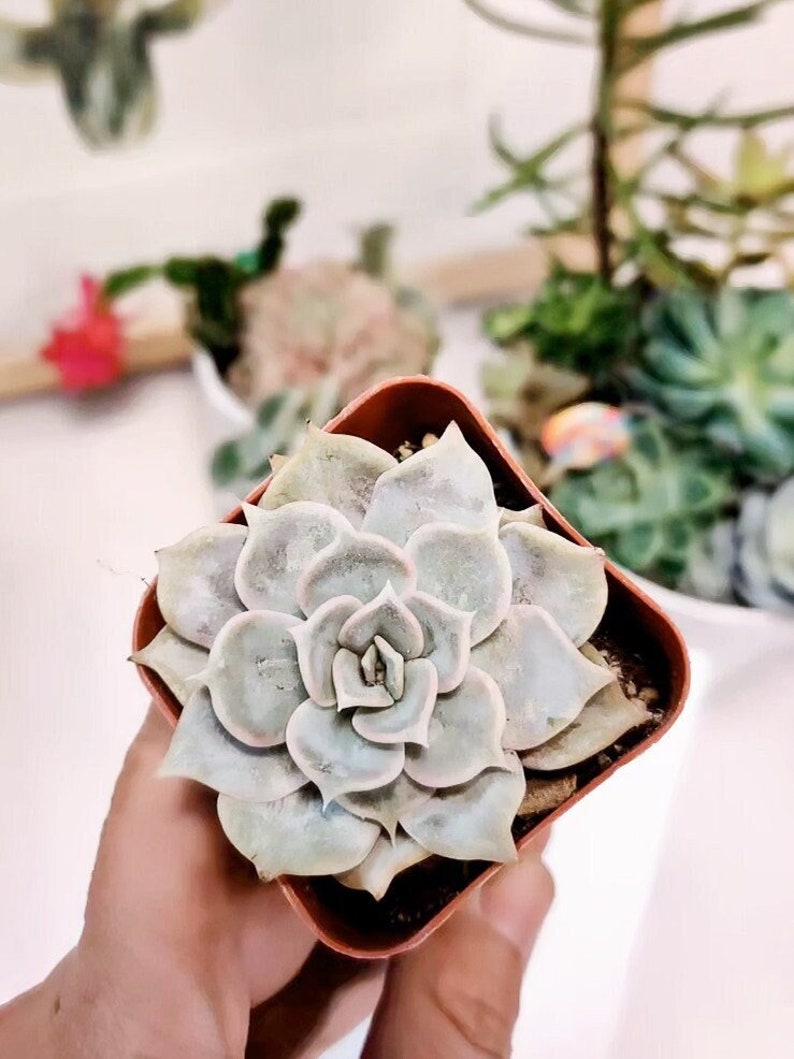
Source: Etsy
Outside, some afternoon shade is recommended in very hot, sunny climates. If the leaves start to brown or redden, that’s a sign it’s getting too much direct sun. Adjust its location or provide more coverage to protect it.

Source: Etsy
With the right amount of bright indirect light, your Echeveria ‘Lilacina’ (Ghost Echeveria) will glow with health. But too much direct sun exposure can give it a sunburn and haunt your succulent parenting skills! So take it slow when transitioning to more sun exposure and keep a close eye on your pale purple plant to make sure it’s staying comfortably shaded from intense rays.
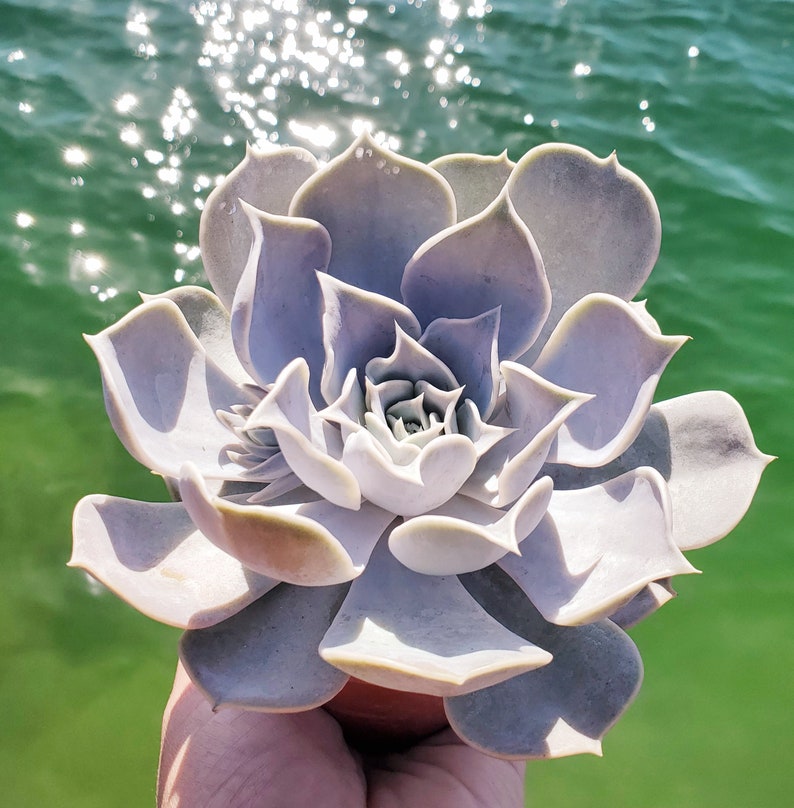
Source: Etsy
Soil for Echeveria lilacina ‘Ghost Echeveria’
To keep your Echeveria ‘Lilacina’ (Ghost Echeveria) from developing rotten roots, fast-draining soil is essential. These succulents can’t handle sitting in soggy soil, so a gritty, porous mix is key. A good recipe is equal parts cactus potting mix or succulent soil and perlite or coarse sand. The chunky perlite or sand helps create air pockets so water drains and oxygen reaches the roots.
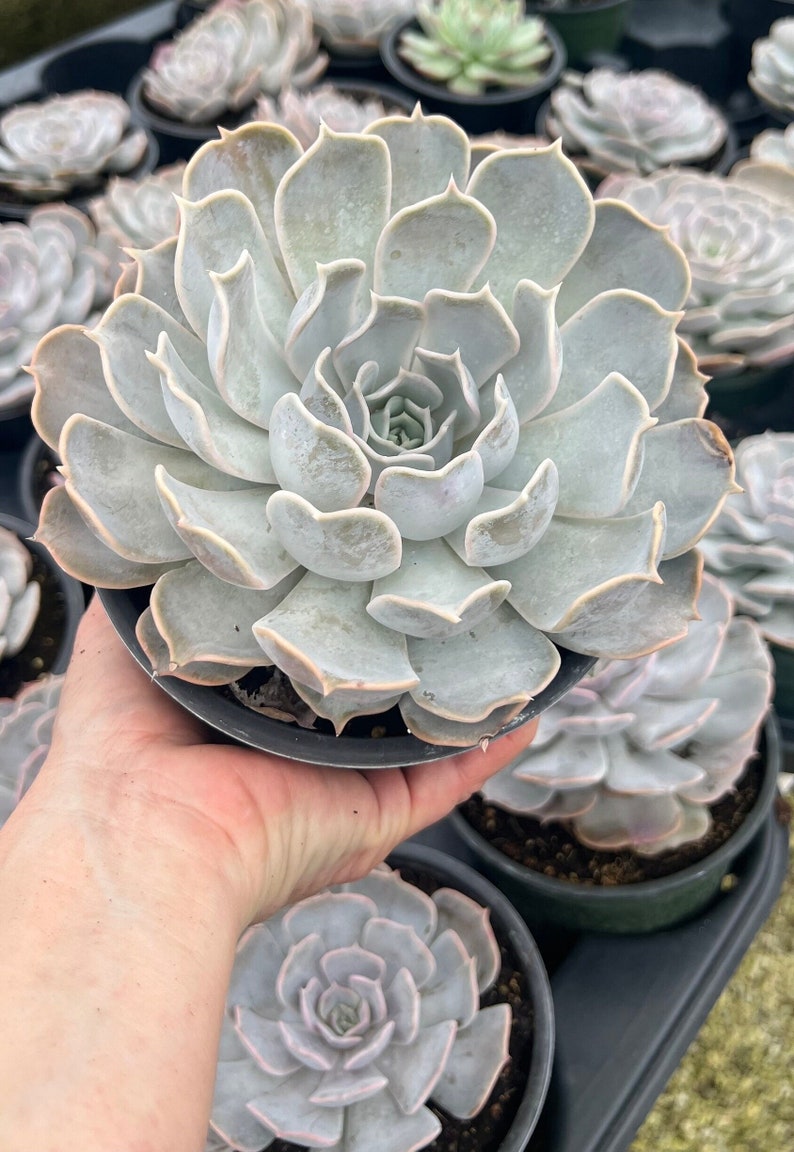
Source: Etsy
Container with Drainage Holes
Be sure to plant Echeveria ‘Lilacina’ (Ghost Echeveria) in a container with drainage holes and avoid heavy clay pots which stay wet longer. Only water when the top inch or so of soil is dry to the touch. Pour water through until it flows out the bottom, but don’t leave your Ghost Echeveria sitting in water.
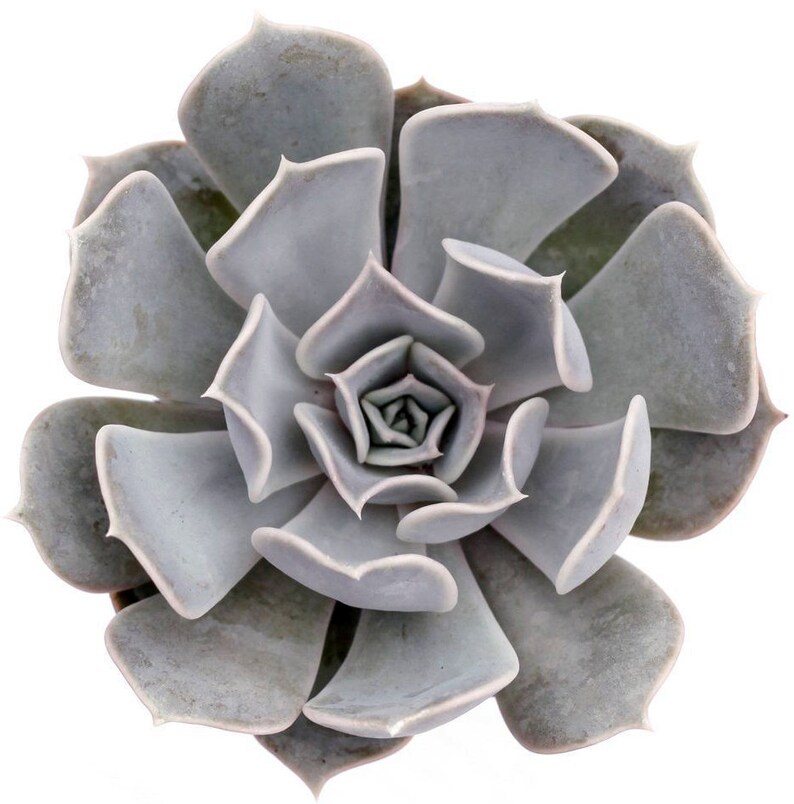
Source: Etsy
Soil
With a quick-draining soil mix and careful watering, your Echeveria ‘Lilacina’ (Ghost Echeveria) can focus on healthy growth rather than battling root rot. The right soil is key to keeping this pale beauty ghostly rather than ghastly!
You might like: Succulent Soil: Ultimate Guide & 4 DIY Recipes to Keep Your Succulents Happy and Healthy

Consider amending your soil with Bonsai Jack’s gritty mix to ensure your succulent soil drains quickly to prevent it from staying moist for too long. Source: Etsy
How to Water Echeveria lilacina ‘Ghost Echeveria’
As a drought-tolerant succulent, your Echeveria ‘Lilacina’ (Ghost Echeveria) doesn’t need or want frequent watering. The key is to let the soil dry out fully between drinks. Only water when the soil is completely dry to the touch.
When it is time to water, give your Echeveria ‘Lilacina’ a good soaking so water flows out the drainage holes at the bottom of the pot. But don’t leave it sitting in water – excess moisture will lead to root rot.
Be sure to wick away any water on the leaves with a tissue after watering. The powdery coating on the leaves can be damaged by moisture, leading to spots or discoloration.
By waiting until the soil is dry to water and taking care to avoid overwatering or wetting the leaves, you’ll help your Echeveria ‘Lilacina’ (Ghost Echeveria) live up to its name rather than meeting an untimely, watery demise!
You might like: How & When to Water Succulents So They Don’t Die
Temperature and Humidity
Echeveria ‘Lilacina’ (Ghost Echeveria) prefers a warm, dry environment and is not tolerant of cold temperatures or high humidity. Keep your plant in a room with temperatures between 60-75°F (15-24°C) and low humidity levels.
Echeveria ‘Lilacina’ (Ghost Echeveria) is a tender succulent that is native to Mexico and is not frost-tolerant. It is best suited for growing in USDA hardiness zones 9-11, which have average minimum temperatures between 20-40°F (-6.7 to 4.4°C). In colder regions, Echeveria ‘Lilacina’ (Ghost Echeveria) can be grown as a houseplant, provided that it is given the right conditions of bright, indirect light, warm temperatures, and well-draining soil.
You might like: Succulent Care by Zones
How to Propagate Echeveria Lilacina ‘Ghost Echeveria’
Propagating your Echeveria ‘Lilacina’ (Ghost Echeveria) is an easy way to get more of these sleek succulents.
Here’s how:
Take 3-4 inch stem cuttings or leaf pullings (whole leaves plus their petiole/stem). Allow the cuttings to dry out for 3-5 days so the cut end can seal over. This prevents infection and helps with rooting.
Prepare a well-draining potting mix, like cactus soil and perlite. Moisten the mix and fill your propagation container or pots.
Dip the cut end of the cuttings in rooting hormone (optional but can speed up root growth). Plant in the prepared soil, burying the cut end in the mix.
Keep the propagating Echeveria ‘Lilacina’ warm (65-75 F) and dry. Mist only the root area occasionally with a spray bottle but avoid soaking the soil.
Check for roots after 4-6 weeks by gently tugging on the cuttings. Once rooted, your new Ghost Echeverias can be transplanted and treated like mature plants.
You might like: Propagating Succulents 4 Ways: The Best Guide Ever
Pests and Diseases That Echeveria ‘Lilacina’ is Susceptible To
The good news is that Echeveria ‘Lilacina’ (Ghost Echeveria) is generally quite resistant to pests and disease. But they can be prone to a couple common succulent pests, including:
Mealybugs: Small white cottony blobs on stems and leaves. Remove with a cotton swab dipped in rubbing alcohol.
Scale insects: Tiny brown bumps that suck sap from leaves and stems. Also remove manually with a cotton swab and alcohol.
If you notice leaves getting discolored, mushy, or showing other signs of disease, excessive moisture is likely to blame. Remove affected leaves and let the soil dry out completely. This will help prevent the spread of fungal or bacterial infections.
With vigilance and quick action if pests or disease do appear, you can keep your Echeveria ‘Lilacina’ ghostly and gorgeous. Regular inspection of leaves and stems, and providing ideal growing conditions will also help avoid issues.
How often should I inspect my Echeveria ‘Lilacina’ for pests and disease?
It’s a good idea to inspect your Echeveria ‘Lilacina’ (Ghost Echeveria) for pests or disease once a week. Since this succulent has pale leaves, it can be easier to spot potential problems early. Check both sides of the leaves and scan the stems for any signs of the common pests, mealybugs and scale. Also look for any spots, discoloration, or mushy areas on leaves or stems, which can indicate a fungal or bacterial issue. Catching any pests or disease early makes them easier to treat and helps prevent damage to your plant. With regular inspection and quick action if needed, you can keep your Ghost Echeveria healthy.
You might like: 12 Succulent Pests and Diseases: Identification, Treatment, and Easy Prevention of Mealybugs, Thrips and More
Echeveria ‘Lilacina’ (Ghost Echeveria) is a beautiful, low-maintenance succulent that is easy to care for. With the proper lighting, soil, watering, and temperature conditions, your Echeveria ‘Lilacina’ should thrive and add a unique touch to your succulent collection.

Where to Buy Succulents Online

